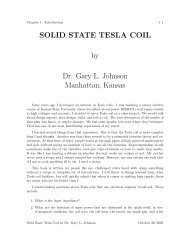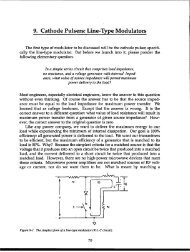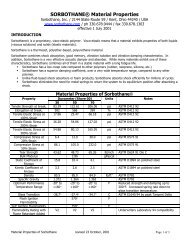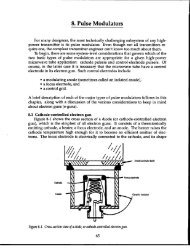3.6M north10.pdf - Dean-O's Toy Box
3.6M north10.pdf - Dean-O's Toy Box
3.6M north10.pdf - Dean-O's Toy Box
Create successful ePaper yourself
Turn your PDF publications into a flip-book with our unique Google optimized e-Paper software.
156 High-Power Microwave-Tube Transmitters I<br />
r<br />
R=2 ;.<br />
But it is always prudent to calculate, or measure, the actual value of dischargeloop<br />
series inductance just to be sure. (This includes the internal series inductance<br />
of the capacitors themselves, which can vary depending upon how they are<br />
internally constructed.)<br />
In at least once case, an energy-storage system with a greatly undermatched<br />
artificial transmission line was used in lieu of a low-inductance capacitor bank<br />
having the same value of capacitance. In this design, characteristic impedance<br />
was 10% of the load impedance. The delay-time of the network was made equal<br />
to 1/2 of the longest pulse duration. The load—a super-power, long-pulse<br />
klystron— was connected in series with a hard-tube modulator switch, much like<br />
the one shown in Fig. 10-3d. When the modulator switch was gated on to initiate<br />
a pulse of load current, there was an instantaneous drop in network voltage of<br />
approximately 0.1 V, where V is the initial voltage across the network. The voltage<br />
across the klystron and modulator-switch combination was 0.9V. This voltage<br />
would persist for a time of 2T, where T is the delay-time of the network. At<br />
2T, the voltage would drop again by an additional O.IV, to 0.8V. If, however, the<br />
modulator switch tube was turned off after time T but before time 2T had elapsed,<br />
most of the network would have been discharged by an amount 0.2V, but not all<br />
of it.<br />
The load current was 0.9 V/R, where R is the effective resistance of the klystron<br />
in series with the conducting-state switch tube. If the storage system used the<br />
same value of capacitance but only the minimum-achievable value of inductance,<br />
the terminal voltage of the bank would start to droop in essentially linear fashion<br />
from the beginning of the current pulse to the end. If the starting voltage is V<br />
and the initial load current was V/R, the total droop would equal to the charge<br />
removed divided by the total capacitance, or AV = IAt/C. (This discussion is<br />
simplified by assuming that current is constant throughout the pulse, which it<br />
isn’t.) The time increment, tit, is the pulse length, 2T, which was the same as<br />
d(LC). The total load resistance was 10ZO, where Zo was the characteristic impedance<br />
of the network described above, or d(L/C). So R = 10~(L/C) and ~(L/C) =<br />
O.lR. Combining things,<br />
Av=<br />
r<br />
IAt ~x2@ 1X2 L ~x2xolR=02v<br />
-F ‘R C= R~= R”” ‘<br />
which was the same as the end-of-pulse step from the distributed network described<br />
above. The charge and energy removed from the capacitance was the<br />
same in both cases, except the finite-ZO network voltage changes in stair-step<br />
fashion while the minimurn-ZO capacitor bank changes in continuous ramp fashion.<br />
The purpose for creating this artificial network was to minimize the anode<br />
dissipation of the modulator switch because the source voltage was constant<br />
throughout the duration of the pulse, at 0.9V. In order to produce a flat-top load







